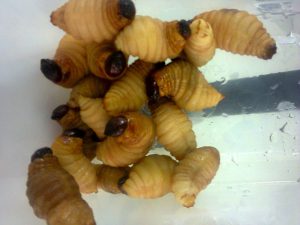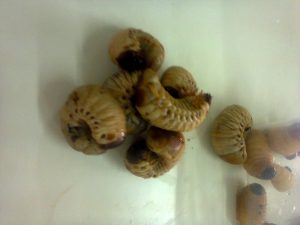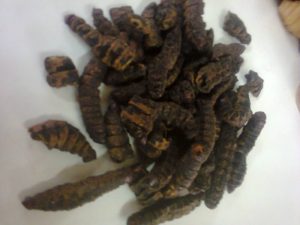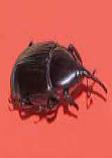This is a guest post by Baseerah Sarumi, an Entomologist with The Federal Institute of Industrial Research (FIIRO) in Nigeria.
INSECTS CONSUMPTION PATTERNS IN THE DIFFERENT GEO-POLITICAL ZONES IN NIGERIA.
Nigeria has its own share of edible insects distributed across the geo-political zones of the country. The practice of insect consumption is an old practice and it cuts across all cultures and ethnic groups in the country. There is barely any zone in Nigeria that is without its own fair distribution of edible insects, because insects have a wide range of host plants. Insects are invertebrate animals and are generally regarded as pests because they attack agricultural produce either on the field or in storage, depending on their host crop. Insects are consumers and decomposers in the food chain. According to Alamu et al (2014), Nigeria has 22 species of edible insects consumed nationwide and they are grouped into six orders. Their availability is based on the planting season or fruiting season of host plants. Edible insects are rich in good protein, good fat, vitamins and minerals.
They are grouped into the following orders:
Order Isoptera: These are the termites, they are found all over the country and their most commonly found species in Nigeria are the Macrotermes spp. They are mostly regarded as pests due to the fact that they feed on cellulose in tree logs or timbers and they are highly destructive because they can reduce tree logs to mere shaft and powder. Despite their negative attributes, they are beneficial insects because they help in the natural recycling process by breaking down dead logs of wood into simpler substance that can easily be taken up by plant roots for photosynthesis, and they are also edible insects.
Termites are highly nutritious and delicious. When collected, they are rinsed, the water on their bodies is allowed to dry off, and then seasoned with salt and sometimes pepper and fried. They are munched and mostly consumed as snacks and eaten all across Nigeria. Usually termites are available at the start of the rainy season and the winged ones are the ones normally consumed. Once the rainy season is fully established and underway, termites are barely available.
Nutritional Qualities of the termite
The crude protein content of the termite, Macrotermes bellicosus ranges from 20.4% (Banjo et al 2006) to 35.88% in Macrotermes nigeriensis (Mba and Elekima, 2007). Carbohydrate or nitrogen-free extract in Macrotermes bellicosus is 43.3% according to Banjo et al (2006). Oil content is 28.37% (Mba and Elekima, 2007). The winged termite, Macrotermes bellicosus is rich in vitamins, ranging from Vitamins: A – 2.89mg/100g; B2 – 1.98mg/100g and; C – 3.41mg/100g. The value of minerals in winged termites is high and ranges from: Calcium – 21mg/100g; Phosphorus – 1.36mg/100g; Iron – 27mg/100g up to; Magnesium – 0.15mg/100g.
Order Coleoptera: These are the beetles. Weevils are beetles with long snout-like extensions at the tip of their head. The larvae of the weevils are the mostly consumed, though, in some parts of Nigeria, the adult beetles are also consumed. The beetles consumed in the country are the yam beetles, dung beetles, African palm-weevil and rhinoceros beetles. They are available in markets in some parts of the country. Weevils are found mainly in the South-West and South-South zones of the country, and can be found in abundance in states like: Lagos, Ogun, Oyo, Ondo, Delta, Edo, Benue, and Cross River. The African palm weevil and rhinoceros beetle larva are found in tree palms. The yam beetle adult feeds on yam tubers in the soil, but also breeds away from the farm near river banks and the larvae feed on grass as well as other organic matters.

Plate 2: African Palm Weevil Larvae

Plate 3: Rhinoceros beetle larvae.
Nutritional value of the African palm weevil.
According to Alamu et al (2014), 27% of insects consumed in Nigeria are coleopterans. They are highly rich in proteins and lipids. Elemo et al (2011) recorded that African palm weevil larva has a protein content of 66% with adequate essential amino acids and lipid content of 37% and it contains high level of potassium and phosphorus as minerals.
Order Lepidoptera: These are the moths and butterflies. Caterpillars of these moths are the most commonly consumed. People in the South-West and North-Central regions of the country see these worms as delicacies. The worms are mostly added to egusi (melon) soup to compliment it. In the case of the Anaphe – silk worm, they are considered to be the most expensive of all edible insects in Nigeria. Most of the caterpillars have hairs on them and these hairs are removed by roasting them in hot ash, rinsed and then sun dried or oven dried. Examples are the silk worm caterpillar (anaphe worm), which are consumed in the South-Western part in Ondo and Ekiti states. Pallid emperor moth larva ( Cirina forda), are consumed in the North-Central region, particularly in Kwara state, and also in the South- Western states of Oyo, Ondo and Ekiti, the Emperor moth larvae (Bunaea anicoe) are consumed according to Alamu et al (2014).
The Pallid Emperor Moth Larva
The pallid emperor moth larva, Cirina forda, commonly known as monimoni locally, is a defoliator of the Shea butter tree. It is not only common to Nigeria but can be found in other West African countries such as Togo, Cameroun, and Ghana. In Nigeria, based on oral interview, it is mostly collected in Saaki, a town in Oyo state. The caterpillars are gathered at their last stage when they drop or crawl from trees in order to pupate. It is only the caterpillars that drop that are gathered, according to the narrative. They are dry-heated in hot ash to remove the hairs, rinsed, sun dried or oven dried before they are packed and sold off in markets.
 `
`
Plate 4: Emperor moth larvae
Order Orthoptera: Grasshoppers, crickets and locusts belong in this order. They are edible insects, delicious and highly nutritious. Grasshoppers are: short horned, long-horned and variegated grasshoppers; crickets are house and mole crickets and; locusts are solitary or gregarious locusts. Grasshoppers are mainly consumed in Maiduguri, the state capital of Bornu in the North-East zone of the country. Crickets are mainly consumed in Benue state, in the North-Central zone; they are usually harvested by men and children who pour water into the holes in which the crickets live in. This makes them hop out and then they are caught. These highly agile orthopterans are killed by freezing them for few minutes before they are roasted. Their wings and limbs are removed before they are consumed. Scientists have worked successfully on crickets, incorporating them into confectionaries by turning them into insect powder.
Order Hymenoptera: These are the bees and wasps. The adult bees use nectar and plant juices to manufacture honey by mixing them with their saliva. The sucrose in the plants extracts is changed into fructose and glucose. Honey is used extensively in both food and pharmaceutical industries because of its antibiotic and anti-oxidant contents.
Order Hemiptera: These are the true bugs. The green stink bug, Nezara viridula, it is mainly consumed in Benue state (Agbidye et al 2009).
Domestication of Edible insects
According to Hoddle (2013) some local farmers in Thailand have established farms of palm weevils. In 2013, a group of students from McGill University, Montreal, Canada, won seed money to develop and process insects into powder (Aspire food group); they also made use of palm weevils. The weevils were reared in plastic boxes and their yields compared favourably with that of those harvested in the wild.
Biology and domestication of Edible palm weevils (Rhynchoporus phoenics)
Adult female palm weevils hatch eggs in crevices or openings in the stem of a tree palm. The eggs of the palm weevils are whitish yellow and cylindrical. They hatch 2-5 days after oviposition. The larvae bore into the soft tissues of the interior of the tree palm and they take about 3 months to be fully developed and undergo 3-7 instars before going into pupation. The pupa period last 14- 21days before an adult insect emerges.

Why eating insects is no more common in Nigeria.
All insects are regarded as pest; something to get rid of! Many people, especially those living in cities are unaware of the nutritional contents in insects. Many people view insects with disgust, and believe that those people that eat insects are primitive, backward and not educated. In Nigeria, edible insect consumption is limited to the rural areas. It is very difficult to get edible insects in Lagos – the commercial nerve-center of the nation, this is because the people’s dietary habit is heavily Americanized and Euro-centric.
Conclusion
The consumption of edible insects should be encouraged. It has been recorded that insects contain as much protein as other conventional protein sources like beef, chicken eggs; pound for pound.
References
Agbidye, F.S., Ofuya, T.I., Akindele, S.O. (2009). Marketability and nutritional qualities of some edible forest insects in Benue State, Nigeria. Pakistan Journal of Nutrition 8(7): 917-922.
Alamu, O. T., Amao, A. O., Nwokedi, C. I., Oke,O. A. and Lawa, I. O. (2013). Diversty and Nutritional Status of Edible Insects in Nigeria: A Review. International Journal of Biodiversity 5(4): 215-222.
Banjo, A. D., Lawal O. A. and Songonuga, E. A. (2006). Nutritional value of fourteen species of edible insects found in Southwestern Nigeria. African Journal of Biotechnology 5(3): 298-301
Elemo, B.O., Elemo, G.N., Makinde, M.A., Erukainure, O.L. (2011). Chemical evaluation of African palm weevil, Rhychophorus phoenicis, larvae as a food source. Journal of Insect Science 11: 146.
Ivbijaro, Matt F. A. (2014): Edible insects of Nigeria. An invited Paper by the Nigerian Field Society Presented at the Lady Bank Anthony Hall, University of Ibadan, Ibadan, January 28, 2014
Mbah, C.E., and G. O. V. Elekima (2007) Nutrient composition of some terrestrial insects in Ahmadu Bello University, Samaru, Zaria Nigeria. Science World Journal 2 (2): 17-20.
http://wikipedia.com/entomophagy
http://cisr.ucr.edu
This article was edited by Abdulghaniy Kayode Otukogbe.The facts, opinions, views or positions expressed or established in guest posts represent that of the writers and not necessarily of www.edusounds.com.ng.
Please, leave your thoughts on this post in the comment section and feel free to share the article with your contacts. Thanks for taking out of your precious time to read my article/s!
If you like this post, kindly subscribe and/or follow me on Twitter @otukogbe and @EdusoundsNg or on Facebook at edusoundsng.